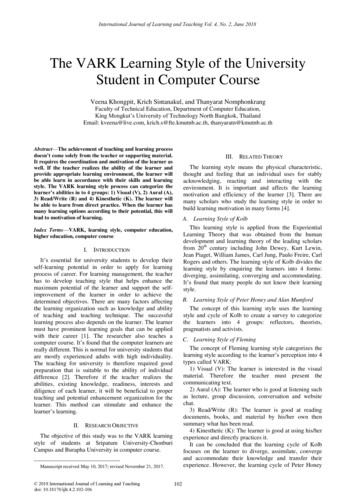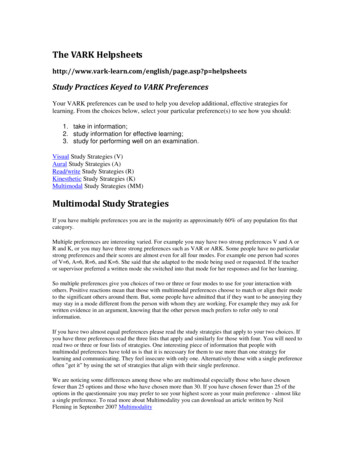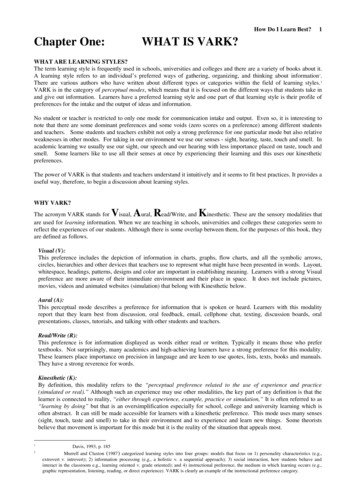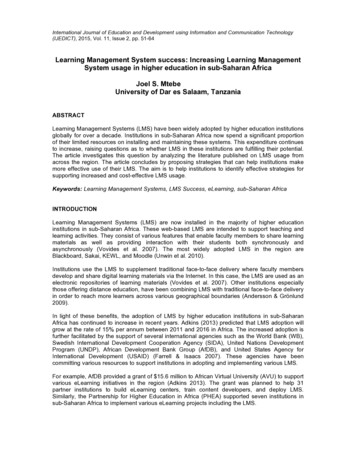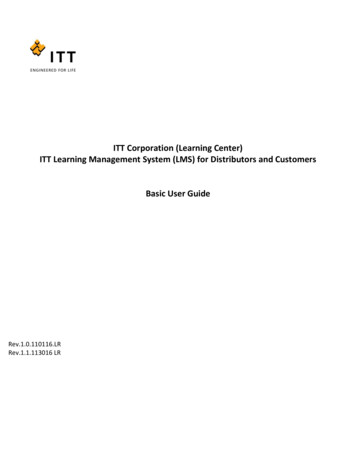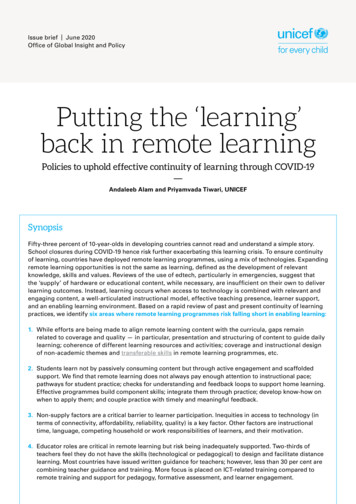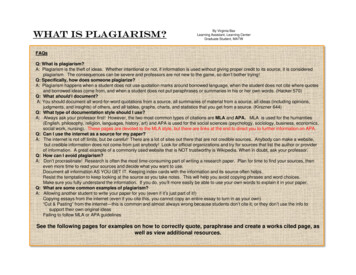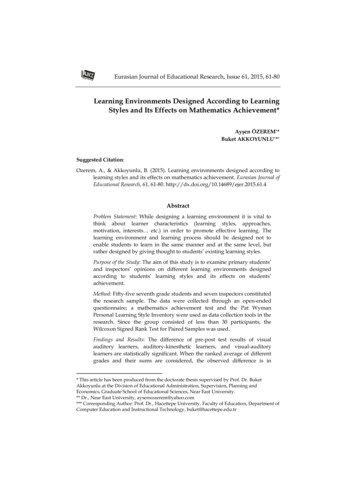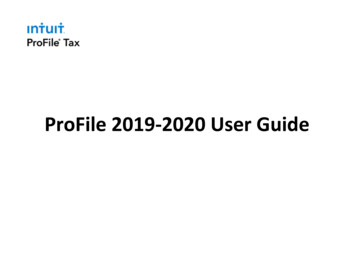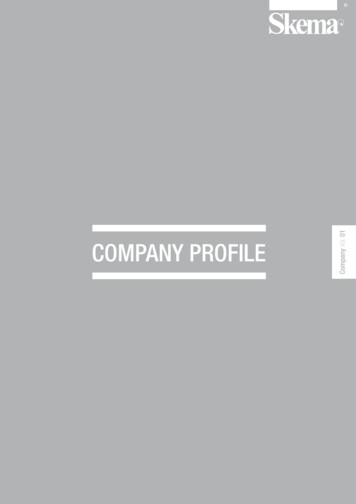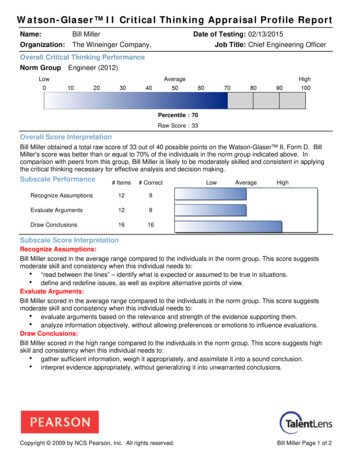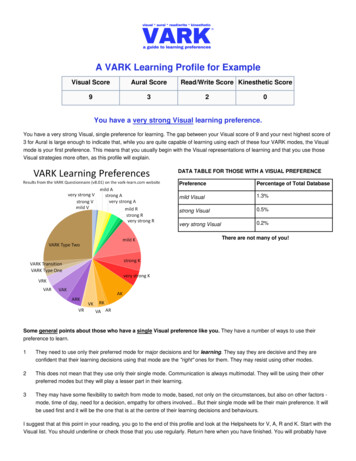
Transcription
A VARK Learning Profile for ExampleVisual ScoreAural Score93Read/Write Score Kinesthetic Score20You have a very strong Visual learning preference.You have a very strong Visual, single preference for learning. The gap between your Visual score of 9 and your next highest score of3 for Aural is large enough to indicate that, while you are quite capable of learning using each of these four VARK modes, the Visualmode is your first preference. This means that you usually begin with the Visual representations of learning and that you use thoseVisual strategies more often, as this profile will explain.DATA TABLE FOR THOSE WITH A VISUAL PREFERENCEPreferencePercentage of Total Databasemild Visual1.3%strong Visual0.5%very strong Visual0.2%There are not many of you!Some general points about those who have a single Visual preference like you. They have a number of ways to use theirpreference to learn.1They need to use only their preferred mode for major decisions and for learning. They say they are decisive and they areconfident that their learning decisions using that mode are the "right" ones for them. They may resist using other modes.2This does not mean that they use only their single mode. Communication is always multimodal. They will be using their otherpreferred modes but they will play a lesser part in their learning.3They may have some flexibility to switch from mode to mode, based, not only on the circumstances, but also on other factors mode, time of day, need for a decision, empathy for others involved. But their single mode will be their main preference. It willbe used first and it will be the one that is at the centre of their learning decisions and behaviours.I suggest that at this point in your reading, you go to the end of this profile and look at the Helpsheets for V, A, R and K. Start with theVisual list. You should underline or check those that you use regularly. Return here when you have finished. You will probably have
checked most strategies in your main list and a few strategies in some of the other lists.YOUR LEARNING PROFILEYou should remember that information does not normally come packaged in a single mode - life is multimodal. When you are facedwith a learning situation that requires Aural or Read/Write or Kinesthetic skills you will probably translate those into your Visual mode.Information in higher education seldom comes in a Visual format so translating has to become a habit. You are not as flexible asmany others and you might prefer to use one particular mode for certain things that "you think" need to be conveyed that way. If yourely too much on your Visual mode your learning may suffer but it can be made stronger.You are less flexible in the way that you receive information from others and you probably switch to accommodate the way that theyare presenting to you. If someone emails or phones you, your Aural score of 3 means that you place some importance on what is saidand what you say. So self-talk, lectures, discussions, debates, meetings and recitation are somewhat secondary but still useful Aurallearning strategies for you. Your Read/write score is 2 and that may be helpful in academic learning so if somebody wants to give yousome print sources about a new concept (Read/write) you are willing to use those as well.Your first preference is Visual and that means that you are keen to use all the graphic and spatial strategies that you can - like thisdiagram above. You often reach for a piece of paper to explain something and you are acutely aware of where you are in space andwhat comprises your immediate environment. You are "spatially aware" of yourself and the environment around you. You want othersto give you the "big picture" so that you can fit your current learning into that overall schema. You like to know how information fitsinto the wider picture. You want the big picture first and the detail later.ADVANTAGES AND DISADVANTAGESYour single preference has both advantages and disadvantages. You can learn things quickly when they are in your mode and youcan often be quite certain of them without having to check their accuracy in other modes. This makes you quite different from most ofthose around you who are multimodal (60% of our database). Students with four similar preferences (multimodals) can make choicesin class. They can match the modes being used by their teachers or the modes used in a particular discipline. They may switchmodes. That is more difficult for you especially if your teachers do not use diagrams, graphs, and charts.You may use just your Visual mode when you believe that nothing else is required, but more often you should realize that you needconfirming information in other modes. You may be in a minority when explaining things your way, or when understanding thingspresented in an Aural, Read/Write or Kinesthetic way. The advantage that you have is that when you do learn something, you learn itquickly - as long as it comes in your mode. The main disadvantage is that when information comes in the Aural, Read/Write orKinesthetic modes you are less inclined to use it, value it, or believe it. You may find it difficult to learn if you cannot translate thatinput into the Visual modes that you use more effectively.If you are a student, you are strongly advantaged when you meet a teacher who can teach using your Visual strategies. You likesubjects that can be taught and learned in a Visual way, such as: economics, physics, logic, art, geography, biology, physiology,geometry, computer systems - any subjects where layout, placement, spatial linkages, maps, flow charts and graphical analysis areimportant. There are fewer opportunities to learn visually in most educational establishments. Read/write students find life easierwhen their education uses print sources, lists and textbooks. You may have learned how to shift any input from Read/write sourcesinto your Visual learning strategies.
NOTE TAKING AND NOTE MAKINGWhen you take notes you need to translate that input quickly into diagrams. Those with a strong Visual preference are able to converttext or talk into their own diagrams. They listen for some key words that have strong visual associations. Some can develop this skillso that they can draw the diagrams as the teacher speaks or as they read. Others have to take down the words as text and convertthem into diagrams later. Here are some examples:The teacher said:I drew:"Our brain absorbs images in different ways.""There is a link between smoking and the incidence of lungcancer.""Between selling your house and buying the next one you mayneed bridging finance."The first stage in gathering information for learning is called note taking because you are merely collecting notes from your teachers,textbooks, friends and webpages. In the Visual helpsheet below we have suggested that you should convert those notes by reducingthem (three pages reduced to one page). This stage is called note making. To do this you should use designs, symbols anddrawings that make sense to you. Not all students take their notes in the same way and some students who have a strong Visualpreference have developed special diagrams and forms of shorthand to represent both common and complex ideas. You need todevelop your own special diagrams to help your brain to remember your notes. Your brain needs your help so make every page anddiagram look different. Design your symbols and abbreviations like icons on a computer.You enjoy teachers who provide you with maps, diagrams and graphic images that illustrate the subjects you are learning. Youshould convert any notes that you are given into diagrams using small symbols (stars, arrows, outline boxes etc) to organize yourmain ideas. Using different fonts,and fontstyles will provide you with plenty of visual variety and make things easier to remember.font sizes Avoid lists and bullet points because to you they all look the same.You may even print things sideways for effect, or use Word Art.All text seems the same for those with a Visual preference soPersonalise your own records as much as possible.Make your notes look different from everyone else's notes.Some examples are shown later in this profile.
The placement of things on a page of your notes is important because you are better able to remember "what" by using "where."Take mental photographs of your pages and your memory will assist in recalling a detail on a page by its placement. Centering, rightjustifying and arranging key words in innovative ways works for you. Color too is important. One student helped to remember keyideas by writing all her Economics notes in red pen, and all her Biology notes in black pen. The color codes helped her recall. It wasas though her brain stored things in different places according to color. So Economics and Biology did not get confused.Cartoons are helpful for those who have a strong Visual preference especially if the meaning in the cartoon is in the drawing ratherthan in the text bubbles. Find cartoons that you can add meaning to with your own words.Remember that video and television are not necessarily useful for those who are strongly Visual (V) because much of the informationin these media is Aural (A), Kinesthetic (K) or even written (R). Students with a Visual preference get little help from unstructuredimages like photographs or films. Videos showing things that you can learn are useful for your Kinesthetic preference. Also be wary ofthose who use PowerPoint. Some students with a strong Visual preference are distracted by the way electronic information appearsand disappears. Most of the content in PowerPoint is little more than words. There are usually few diagrams even though the textmay be shown in interesting (and diverting!) ways. PowerPoint is often referred to as a visual medium but in terms of modalpreferences it is usually filled with text and favors students who have a Read/write preference.WORKING WITH OTHER LEARNERSIf you are well matched with others who have a Visual preference (V) there will be no problems with communicating ideas andinstructions because you will both be reaching for pieces of paper to sketch designs, or directions, or ideas. Those who prefer visualinput are often keen to see an overview of the situation in a diagram whether it is a customer complaint or a design fault in a system.They mentally convert text and speech into pictures, schemas or images that make more sense in their world. If you are working withsomeone who has some Visual preference too, it will be important to draft any plans or new ideas in a Visual way. You prefer chartsand graphs over tables of figures so translate percentages and ratios into pie or line graphs. Sometimes those with a Visualpreference appear to be inattentive. They may be forming a visual representation of what is being said or what is written. You cansometimes observe them reaching for a pen and paper to start drawing something or thinking about a suitable image. They maydesign their information using symbols as in this example:Those with a Visual preference like to "see" relationships and they often choose to use words like, "link", "draw", "vision", "view","see" or "perspective". They have a strong spatial sense and are often able to find their way when others cannot. They are usuallyaware of their surroundings, especially the layout of rooms or houses or outdoor spaces. They may have a strong sense of color,location, placement, even negative space and they enjoy working with maps, signs and anything that is symbolic (flags, logos, roadsigns, advertisements, designs and plans). Some can use their preference to remember people's faces but not their names!Those with a strong single Visual preference appear to be a small proportion of the total population but they are an important groupbecause of the extensive use of visual symbolism in our, and other societies. The familiar visual elements such as space, color andrepresentation are often the distinguishing features of different societies and our symbols tend to be drawn with a strong culturalinfluence. Even within a culture, visual conventions change, probably faster than some word meanings. Graphics are closely linkedwith trends and fashions and they are often the subject of competitive development as in the current race to design new fonts for text!The commercial strength of visual images can be seen in fashion, marketing and branding.
As individuals, we all possess a visual vocabulary but it is highly personal because the conventions are not as strongly formalized asfor text. There are few visual dictionaries that might indicate what symbols mean although there are a number of internationallyaccepted signs. The separation of text and pictures, and the so-called higher status of text, makes for a division that is unhelpful forlearners. It would be more helpful if those with a Visual preference were recognized as being different rather than disabled. Weshould reward those who use their Visual preferences to extend their understanding of the written and spoken word. They often havehighly developed abilities to transform knowledge from one mode to another and should be encouraged to continue that process. It isprobably our society's insistence that things must be written down that imposes restrictions on their learning.You chose 3 for the Aural mode. This preference helps when you choose discussion, email, phone conversations, asking questions,and texting as well as listening to lectures and teachers. People with this preference like oral stories and anecdotes that provideexamples of learning. Finding somebody to listen and respond is a useful strategy for this preference. You use this mode when youseek experts to get advice. You can learn by talking things through, and that includes self-talk.Your score of 2 was for the Read/write mode. It offers more strategies for you to use. Having Read/write as a part of your profile ofpreferences is help
Visual strategies more often, as this profile will explain. Some general points about those who have a single Visual preference like you. They have a number of ways to use their preference to learn. I suggest that at this point in your reading, you go to the end of this profile and look at the Helpsheets for V, A, R and K. Start with the Visual list. You should underline or check those that you use regularly. Return
